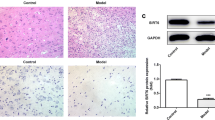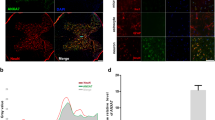Abstract
Purpose
The present work focused on exploring the role of circRNA3616 in neuronal inflammation and apoptosis in spinal cord injury (SCI).
Methods
The SCI mouse model and circRNA3616 knockdown SCI mouse model were established. This work focused on assessing the mouse locomotor function using Basso Mouse Scale (BMS) and BMS subscore. Hematoxylin–eosin (HE) staining and Tunel staining were conducted, while myeloperoxidase (MPO) activity was also detected on spinal cord tissues. We also knocked down circRNA3616 expression in NSC-34 cells. Meanwhile, the SCI cell model was established by oxygen glucose deprivation (OGD) in NSC-34 cells. Moreover, we conducted dual-luciferase reporter gene assay. Flow cytometry (FCM) was conducted to detect SCI cell apoptosis, whereas cell counting kit-8 (CCK-8) assay was performed to analyze cell viability. This study also implemented enzyme-linked immunosorbent assay to detect inflammatory factors in spinal cord tissues, serum, and cells.
Results
CircRNA3616 knockdown reduced the damage, inflammatory response, apoptosis, and MPO activity in SCI mouse serum and spinal cord tissues. CircRNA3616 knockdown increased BMS and BMS subscore of SCI mice. CircRNA3616 up-regulated TLR4 expression by sponging miR-137. CircRNA3616 knockdown inhibited the TLR4, p-IkBα, p-p65/p65 protein expression, while promoting IkBα protein expression within SCI mouse spinal cord. TLR4 reversed circRNA3616 knockdown-induced inhibition on NF-κB pathway activity in SCI cells. CircRNA3616 knockdown attenuated neuronal cell inflammation and apoptosis via TLR4/NF-κB pathway after SCI.
Conclusion
CircRNA3616 silencing attenuates inflammation and apoptosis in SCI by inhibiting TLR4/NF-κB activity via sponging miR-137. CircRNA3616 is the possible anti-SCI therapeutic target.






Similar content being viewed by others
Data availability
Obtained in connection with the corresponding author.
References
Hauwe L, Sundgren PC, Flanders, AE (2020) Spinal trauma and spinal cord injury (SCI).
Qin C et al (2018) Circular RNA expression alteration and bioinformatics analysis in rats after traumatic spinal cord injury. Front Mol Neurosci 11:497
Karamian BA et al (2022) The role of electrical stimulation for rehabilitation and regeneration after spinal cord injury. J Orthop Traumatol 23(1):2
Yao Y et al (2022) circ_014260/miR-384/THBS1 aggravates spinal cord injury in rats by promoting neuronal apoptosis and endoplasmic reticulum stress. Am J Transl Res 14(1):518–533
Tong D et al (2021) Circ-Usp10 promotes microglial activation and induces neuronal death by targeting miRNA-152–5p/CD84. Bioengineering 12(2):10812–10822
Kaplan B, Levenberg S (2022) The role of biomaterials in peripheral nerve and spinal cord injury: a review. IJMS 23(3):1244
Zhao J et al (2020) A circRNA derived from linear HIPK3 relieves the neuronal cell apoptosis in spinal cord injury via ceRNA pattern. Biochem Biophys Res Commun 528(2):359–367
Wu R et al (2019) Differential circular RNA expression profiles following spinal cord injury in rats: a temporal and experimental analysis. Front Neurosci 13:1303
Yao C, Yu B (2019) Role of long noncoding RNAs and circular RNAs in nerve regeneration. Front Mol Neurosci 12:165
Wu F et al (2019) Circular RNA TLK1 aggravates neuronal injury and neurological deficits after ischemic stroke via miR-335–3p/TIPARP. J. Neurosci. 39(37):7369–7393
Zhou W et al (2021) research progress on the regulation of nutrition and immunity by microRNAs in fish. Fish Shellfish Immunol 6:1–8
Wang WZ et al (2021) Role of circular RNA expression in the pathological progression after spinal cord injury. Neural Regen Res 16(10):2048–2055
Peng P et al (2020) Identification of a circRNA-miRNA-mRNA network to explore the effects of circRNAs on pathogenesis and treatment of spinal cord injury. Life Sci 257:118039
Yao Y et al (2020) Microarray assay of circular RNAs reveals cicRNA.7079 as a new anti-apoptotic molecule in spinal cord injury in mice. Brain Res Bull 164:157–171
Vafaei-Nezhad S et al (2020) A review of low-level laser therapy for spinal cord injury: challenges and safety. J Lasers Med Sci 11(4):363–368
Balolu M, Zkorkmaz EG (2019) Neuroprotective effects of allopurinol on spinal cord injury in rats: a biochemical and immunohistochemical study. Folia Morphologica 78:676–683
Zhou J et al (2019) miR-34a alleviates spinal cord injury via TLR4 signaling by inhibiting HMGB-1. Exp Ther Med 17(3):1912–1918
Xia H et al (2020) Catalpol protects against spinal cord injury in mice through regulating microRNA-142-mediated HMGB1/TLR4/NF-κB signaling pathway. Front Pharmacol 11:630222
Kang N et al (2015) Hyperbaric oxygen intervention reduces secondary spinal cord injury in rats via regulation of HMGB1/TLR4/NF-κB signaling pathway. Int J Clin Exp Pathol 8(2):1141–1153
Yang Y et al (2017) BAMBI inhibits inflammation through the activation of autophagy in experimental spinal cord injury. Int J Mol Med 39(2):423–429
Li J et al (2015) Sex hormones regulate cerebral drug metabolism via brain miRNAs: down-regulation of brain CYP2D by androgens reduces the analgesic effects of tramadol. Br J Pharmacol 172(19):4639–4654
Jiang W et al (2017) Targeting the NLRP3 inflammasome to attenuate spinal cord injury in mice. J Neuroinflammation 14(1):207
Basso DM et al (2006) Basso Mouse Scale for locomotion detects differences in recovery after spinal cord injury in five common mouse strains. J Neurotrauma 23(5):635–659
Sun L et al (2017) Inhibition of HMGB1 reduces rat spinal cord astrocytic swelling and AQP4 expression after oxygen-glucose deprivation and reoxygenation via TLR4 and NF-κB signaling in an IL-6-dependent manner. J Neuroinflammation 14(1):231
Chen S et al (2020) Time-course changes and role of autophagy in primary spinal motor neurons subjected to oxygen-glucose deprivation: insights into autophagy changes in a cellular model of spinal cord ischemia. Front Cell Neurosci 14:38
Qin C et al (2019) Circular RNA expression alteration and bioinformatics analysis in rats after traumatic spinal cord injury. Front Mol Neurosci. https://doi.org/10.3389/fnmol.2018.00497
Chen J et al (2021) Novel circular RNA 2960 contributes to secondary damage of spinal cord injury by sponging miRNA-124. J Comp Neurol 529(7):1456–1464
He R et al (2020) Quietness Circ 0000962 promoted nerve cell inflammation through PIK3CA/Akt/NF-κB signaling by miR-302b-3p in spinal cord injury. Ann Palliat Med 9(2):190–198
Bai S et al (2020) Construct a circRNA/miRNA/mRNA regulatory network to explore potential pathogenesis and therapy options of clear cell renal cell carcinoma. Sci Rep 10(1):13659
Li Z et al (2019) Tumor-suppressive circular RNAs: Mechanisms underlying their suppression of tumor occurrence and use as therapeutic targets. Cancer Sci 110(12):3630–3638
Zhang Q et al (2020) Roles of circRNAs in the tumour microenvironment. Mol Cancer 19(1):14
Greene J et al (2017) Circular RNAs: biogenesis, function and role in human diseases. Front Mol Biosci. https://doi.org/10.3389/fmolb.2017.00038
Dai J et al (2018) MiR-137 attenuates spinal cord injury by modulating NEUROD4 through reducing inflammation and oxidative stress. Eur Rev Med Pharmacol Sci 22(7):1884–1890
Gao L et al (2018) MiR-137 inhibited inflammatory response and apoptosis after spinal cord injury via targeting of MK2. J Cell Biochem 119(4):3280–3292
Li W et al (2021) MicroRNA-137-mediated lysine demethylase 4A regulates the recovery of spinal cord injury via the SFRP4-Wnt/β-Catenin axis. Int J Neurosci. https://doi.org/10.1080/00207454.2021.1881093
Daniela, et al (2015) Role of Toll like receptor 4 signaling pathway in the secondary damage induced by experimental spinal cord injury. Immunobiology 220:1039–1049
Caso JR et al (2007) Toll-like receptor 4 is involved in brain damage and inflammation after experimental stroke. Circulation 115(12):1599–1608
Xu S et al (2020) TLR4 promotes microglial pyroptosis via lncRNA-F630028O10Rik by activating PI3K/AKT pathway after spinal cord injury. Cell Death Dis 11(8):693
Zhang P et al (2018) Over-expressed miR-27a-3p inhibits inflammatory response to spinal cord injury by decreasing TLR4. Eur Rev Med Pharmacol Sci 22(17):5416–5423
Wang B et al (2019) miR-940 promotes spinal cord injury recovery by inhibiting TLR4/NF-κB pathway-mediated inflammation. Eur Rev Med Pharmacol Sci 23(8):3190–3197
Chen J et al (2017) Neuron and microglia/macrophage-derived FGF10 activate neuronal FGFR2/PI3K/Akt signaling and inhibit microglia/macrophages TLR4/NF-κB-dependent neuroinflammation to improve functional recovery after spinal cord injury. Cell Death Dis 8(10):e3090
Wan G et al (2020) MicroRNA-129–5p alleviates spinal cord injury in mice via suppressing the apoptosis and inflammatory response through HMGB1/TLR4/NF-κB pathway. Biosci Rep. https://doi.org/10.1042/BSR20193315
Yang W et al (2018) TRIM52 plays an oncogenic role in ovarian cancer associated with NF-kB pathway. Cell Death Dis 9(9):908
Peng D et al (2020) Sodium para-aminosalicylic acid inhibits manganese-induced NLRP3 inflammasome-dependent pyroptosis by inhibiting NF-κB pathway activation and oxidative stress. J Neuroinflammation 17(1):343
Li XH, Fu NS, Xing ZM (2019) MiR-100 suppresses inflammatory activation of microglia and neuronal apoptosis following spinal cord injury via TLR4/NF-κB pathway. Eur Rev Med Pharmacol Sci 23(20):8713–8720
Acknowledgements
None.
Author information
Authors and Affiliations
Contributions
LW: conception and design and analysis of data. LW, ZS, HZ, HC, YH, XL and JL performed the experiments. HZ, HC, YH, XL and JL: drafting the article. LW and ZS: revision of the article critically for important intellectual content.
Corresponding author
Ethics declarations
Conflict of interest
The Authors declare that they have no conflicts of interest to disclose.
Additional information
Publisher's Note
Springer Nature remains neutral with regard to jurisdictional claims in published maps and institutional affiliations.
Supplementary Information
Below is the link to the electronic supplementary material.
Rights and permissions
About this article
Cite this article
Wang, L., Song, Z., Zou, H. et al. CircRNA3616 knockdown attenuates inflammation and apoptosis in spinal cord injury by inhibiting TLR4/NF-κB activity via sponging miR-137. Mol Cell Biochem 478, 329–341 (2023). https://doi.org/10.1007/s11010-022-04509-x
Received:
Accepted:
Published:
Issue Date:
DOI: https://doi.org/10.1007/s11010-022-04509-x




